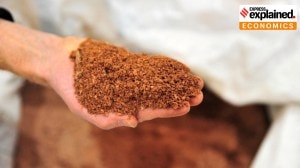Your millet guide: Why is bajra porridge good for breakfast and ragi roti best for lunch?
Combine millets with legumes like lentils, chickpeas or beans to create a complete protein source that rivals meat. Pair them with a colourful array of vegetables to enhance the fibre, vitamin and mineral content of your meals. But watch your portions, say nutritionists
 Milk or dairy alternatives can be added to millet porridge for added creaminess and calcium (Freepik)
Milk or dairy alternatives can be added to millet porridge for added creaminess and calcium (Freepik)By now, most of you are aware of the superfood qualities of millet. What you need to know is that even though it is a healthier grain alternative, you need to exercise portion control because its carbohydrate content (78 per cent) is almost equal to that of rice (82 per cent) and wheat (76 per cent). However, it scores over rice and wheat because it is rich in complex carbohydrates, fibres, protein, antioxidants, B vitamins and micronutrients. All of these add heft to the meal, keep you full longer, slow down food breakdown and prevent blood sugar spikes. And that counts big among Indians who have a big burden of diabetes and cardiovascular diseases.
WHAT’S THE RIGHT PORTION SIZE?
“The recommended portion size of cooked millets is approximately half to one cup, depending on your dietary needs and calorie intake. Remember you must not cross your daily calorie count and overindulge. You can combine millets with a range of other grains, vegetables and proteins to ensure you receive a wide spectrum of nutrients,” says Dr Priyanka Rohatgi, Chief Nutritionist, Apollo Hospitals.
WHY MILLETS ARE MORE BENEFICIAL THAN OTHER GRAINS?
Millets outscore any other grain when it comes to fibre. “Pearl millets (bajra) have around 1.3 to 1.8 grams of dietary fibre, foxtail millets have around 3 to 3.5 grams, finger millets (ragi) have around 10 to 11.5 grams, little millets, around 7 to 8 grams, Kodo millet around 8 to 9 grams and barnyard millet around 10 to 10.5 grams,” says Dr Priya Augusthy, nutritionist and medical officer, Clinic of Natural Medicine, CGH Earth.
“As for proteins, pearl millet (bajra) has around 8-12 grams, foxtail millet 10-12 grams and finger millet (ragi) around 7-10 grams. Other millet varieties like little millet, Kodo and barnyard contain around 7-12 grams of protein. Pearl millets (bajra) and finger millets (ragi) are rich in B vitamins such as thiamin (B1), riboflavin (B2), niacin (B3), pantothenic acid (B5), pyridoxine (B6), and folate (B9). These vitamins play crucial roles in energy metabolism, nerve function and red blood cell production. Foxtail millets are known for their relatively higher vitamin E content that protects cells from oxidative damage. Finger millets (ragi) are good sources of vitamin K, A, calcium, selenium and iron, which is an essential mineral for oxygen transport in the blood and prevention of anaemia. Finger millets (ragi) and sorghum (jowar) are rich in phenolic compounds such as ferulic acid, caffeic acid and quercetin, all of them antioxidants. Certain millets contain enzymes like superoxide dismutase (SOD), the antioxidant enzyme that helps neutralise harmful superoxide radicals,” she adds.
MILLETS ARE GLUTEN-FREE AND HAVE LOW GI
Millets are naturally gluten-free and have a low glycemic index (GI), which means they have a slower impact on blood sugar levels. “Foxtail millets have a GI of around 50-70, depending on the variety and preparation. Pearl millets (bajra) have a GI of around 50-60. Finger millets (ragi) have a low GI of around 50-60 due to their higher fibre content,” says Dr Augusthy.
HOW TO INCLUDE MILLETS IN YOUR MEALS
Dr Rohatgi suggests various alternatives so that you can have variety in your meals. “You can have pearl millets as a breakfast porridge, topped with fruits, nuts and honey. You can have them as a healthy substitute for rice in dishes like biryani, pilaf or even sushi. Millet flour can be used in baking, making delicious and gluten-free bread, muffins and pancakes. Roasted millet grains can be sprinkled on salads or used as a crunchy topping for yogurt. Add millets to soups and stews for a nutrient boost and a heartier texture,” she adds.
WHAT IS THE BEST TIME TO HAVE MILLETS?
The timing of millet consumption can play a role in optimising its benefits. According to Dr Rohatgi, breakfast is the best time because millets can then ensure a sustained release of energy throughout the morning, keeping you full and focussed. “Substitute rice or wheat with millets in your lunchtime dishes like salads, wraps or grain bowls. This can help stabilise blood sugar levels and prevent post-meal energy crashes. Including millets in your evening meal can aid in digestion and promote a restful night’s sleep due to their rich fibre content,” she says.
THE BEST FOOD COMBINATIONS
To maximise the nutritional benefits of millets, consider these compatible food combinations. “That way you can get a bouquet of nutrients that a single food item cannot guarantee. Combine millets with legumes like lentils, chickpeas or beans to create a complete protein source that rivals meat. Pair them with a colourful array of vegetables to enhance the vitamin and mineral content of your meals. Milk or dairy alternatives can be added to millet porridge for added creaminess and calcium. Sprinkle chopped nuts or seeds like almonds, flaxseeds or chia seeds onto your millet-based dishes for healthy fats and crunch. Use herbs and spices to enhance the flavour of your millet dishes without relying on excessive salt or unhealthy fats,” says Dr Rohatgi.





- 0114 hours ago
- 0214 hours ago
- 0314 hours ago
- 0414 hours ago
- 054 hours ago


























